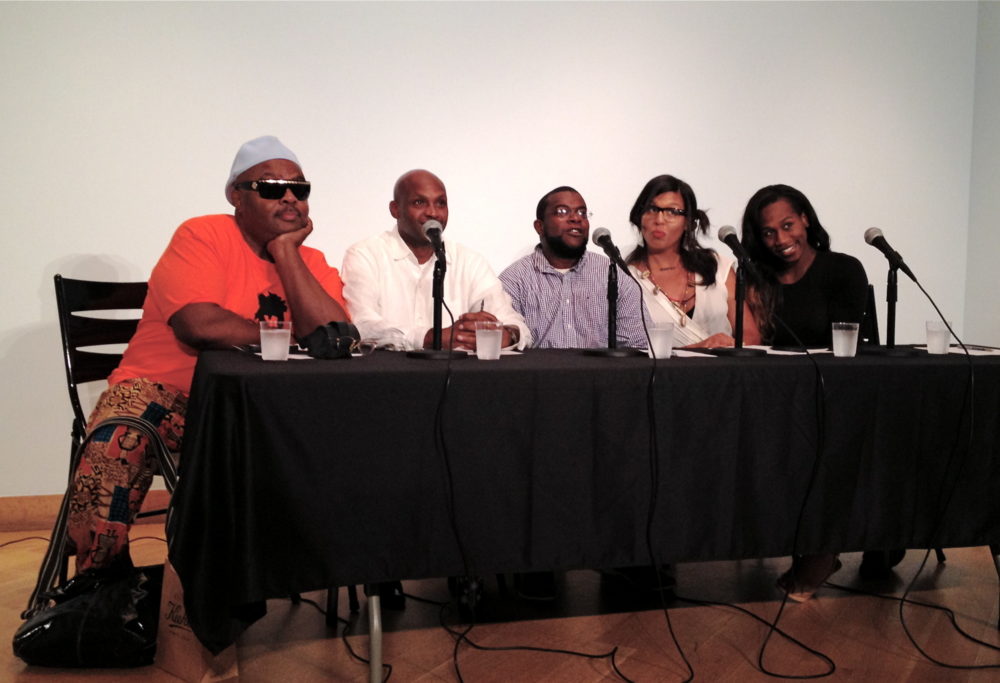Last week the staff of Visual AIDS was not able to attend "A House is My Home" at the Leslie-Lohman Museum of Gay and Lesbian Art, as we were hosting "Party Picks and Love Stories: An Archive Salon" at the gallery Salon 94. Luckily for us our friend David Serotte was able to make it out and provided us with this dispatch.
Our House
By David Serotte
Eagerly waiting for the Ballroom panel discussion, “A House is My Home,” to begin at the Leslie-Lohman Museum of Gay and Lesbian Art, I was reminded of my first experience going to a House Ball in New York City: I arrived too early. Balls typically begin at one or two in the morning. I walked into the venue for my first ball at eleven in the evening. In the ‘70s and ‘80s, balls would begin even later, enabling Ballroom participants to safely navigate the hostile streets that separated them from the sanctuary of Ballroom.
Coinciding with Leslie-Lohman’s recent exhibition, “Queers in Exile: the Unforgotten Legacies of LGBTQ Homeless Youth”, “A House is My Home” explored the ways homelessness has literally and symbolically impacted the House/Ballroom Scene, a creative collective and kinship system established and sustained by Black and Latino/a transgender, lesbian, bisexual and gay individuals. The event’s five panelists represented five generations of Ballroom’s past, present and future. Father Michael Roberson Garçon moderated the panel and educated the audience with interdisciplinary flair, preceding a video presentation of lip-syncing and voguing with the Black church tradition of call-and-response. In unison, we recited, “Marsha P. Johnson, we speak your name. Crystal Labeija, we speak your name.” Shortly thereafter, we watched an excerpt from Jennie Livingston’s Paris is Burning, in which panelist Pioneer Icon Junior Labeija passionately declares his oft-quoted proclamation, “Opulence… You own everything!” Within the context of homelessness, the bitter irony of this line testifies to the Ballroom Community’s ability to transform oppression and disenfranchisement into witty satire.
Indeed, Ballroom’s origins served as a physical and spiritual respite for queer people of color since the early 20th century. As Michael Garçon emphasized, saloons, rent parties and drag balls provided the only safe spaces for black queers following the Great Migration. In 1972, Ballroom carried on this legacy when drag balls evolved into house balls. Tragically, this transition facilitated another form of “homelessness,” as Ballroom’s subsequent influx of gay male participants outnumbered and marginalized the transgender population that largely created it. This idea of queers colluding in the homelessness of their own brothers and sisters was poignantly reiterated throughout the evening. From revisionists excluding the transgender gay rights pioneers of color, Marsha P. Johnson and Sylvia Rivera, from the history of (white) gay liberation, to privileged gays prioritizing marriage equality over the dire needs of queer homeless youth, panelist Icon Sean Ebony put it best when he said, “Obviously, they’re not from our community.”
The Ballroom Community is truly a self-sustaining subculture. Even before the intervention of health service agencies, Ballroom’s leaders provided queer homeless youth with a place of belonging and support. In the Ballroom lexicon, a “house” is defined as a team of people who compete under a common surname, such as “Mizrahi” or “Ebony.” A house can take the form of a sports team, a sorority, a gang and/or a family. Sean Ebony was able to provide physical housing for queer youth since his grandmother owned available property on Madison Avenue. Sean described how people could simply ask anyone in his neighborhood where he lived and they would be pointed in the right direction. This is what community looks like.
A chronological narrative of displacement and erasure surfaced throughout the evening’s testimonies and anecdotes. Junior Labeija mentioned that queer people occupied The Piers because they could no longer live in NYC’s bathhouses after they were closed. Michael Garçon reminded us that Marsha P. Johnson lived on The Piers until her corpse was discovered floating in the Hudson River following the 1992 Pride March. Now that The Piers have become gentrified and policed, queer people occupy other parts of the West Village. Last May, Mark Carson, a member of the Ballroom Community, was targeted and killed for being gay in Greenwich Village.
I think back to the night I attended my first Ball. I remember asking myself, “Why does this need to start so late, and on a Sunday?!” While tradition and availability are likely factors, I’ve come to realize that queer people’s safety remains the most important. In the face of such infuriating loss, we must ask ourselves, “What safe queer space is left in a city inhabited by so many queer people and their history?” Thankfully, we have institutions like the Leslie-Lohman Museum of Gay and Lesbian Art. After all, what is a museum of gay and lesbian art if not a home for the queer culture that produces it? In collectively remembering lost queer spaces like The Piers, we open up space for queer history in the minds of our youth. As we continue to fight for our existence, we must remember that the most precious queer space exists within us. As Junior Labeija so eloquently phrased it: “the worst place to be homeless is in the mind.”
David Serotte is an independent curator living in Baltimore and New York City. He received his B.A. in Art History from Skidmore College. He has worked for The New Museum, Artists Space, Tacoma Art Museum and The Tang Museum. Last summer, he curated BLOODBROTHERS for the Visual AIDS web gallery series. In September, he will perform a dance piece exploring the intersections of Voguing and Butoh at the High Zero Festival of Experimental Improvised Music in Baltimore. He is a Baltimore native and a proud member of the Iconic House of Revlon. View BLOOD BROTHERS, a web gallery he curated for Visual AIDS. You can contact him at dserotte@gmail.com.
